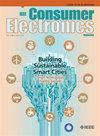Intelligent Resource Utilization in UAV-Assisted Consumer IoT Using DFA-IRS
IF 10.9
2区 计算机科学
Q1 ENGINEERING, ELECTRICAL & ELECTRONIC
引用次数: 0
Abstract
Emerging consumer electronics ecosystem leverage on Internet-of-Things (IoT) for real-time data flow among large number of interconnected devices. The integration of uncrewed aerial vehicles (UAVs) offers enhanced mobility, automation and innovative aerial perspectives with applications in environmental monitoring, object tracking, crop monitoring and surveillance. But the UAV assisted consumer IoT suffers from the challenge of poor communication support and poor resource management. This paper presents a UAV aided consumer IoT network which utilises double faced active intelligent reflecting surface (DFA-IRS). The DFA-IRS makes use of element pairs on opposite faces to extend communication support to multiple consumer nodes. Further, an intelligent resource utilization algorithm is proposed that associates each IoT node to each DFA-IRS element using optimal phase shifts and maximum signal-to-interference-plus-noise-ratio (SINR). The mathematical formulations for DFA-IRS signal modelling and achievable rate are also obtained. It is observed that DFA-IRS system with per element maximum amplification gain基于DFA-IRS的无人机辅助消费物联网智能资源利用
新兴的消费电子生态系统利用物联网(IoT)在大量互联设备之间实现实时数据流。无人驾驶飞行器(uav)的集成提供了增强的机动性、自动化和创新的空中视角,应用于环境监测、目标跟踪、作物监测和监视。但无人机辅助消费物联网面临通信支持差和资源管理差的挑战。提出了一种利用双面主动智能反射面(DFA-IRS)的无人机辅助消费物联网网络。DFA-IRS利用相反面的元素对将通信支持扩展到多个消费者节点。此外,提出了一种智能资源利用算法,该算法使用最优相移和最大信噪比(SINR)将每个物联网节点与每个DFA-IRS元素关联。给出了DFA-IRS信号建模和可实现率的数学表达式。结果表明,当单元件最大放大增益$\alpha ^{max}_{n}$为30 dB时,DFA-IRS系统的增益提高了15.4倍% in achieved data rate over $\alpha ^{max}_{n}$ of 20 dB. Also, the achievable rate improves by 7.8% with optimal phase shifts $\theta _{opt,n}$ . In the end, the performance of DFA-IRS assisted UAV system scenario is compared with other UAV systems aided with conventional IRSs designs.
本文章由计算机程序翻译,如有差异,请以英文原文为准。
求助全文
约1分钟内获得全文
求助全文
来源期刊
CiteScore
7.70
自引率
9.30%
发文量
59
审稿时长
3.3 months
期刊介绍:
The main focus for the IEEE Transactions on Consumer Electronics is the engineering and research aspects of the theory, design, construction, manufacture or end use of mass market electronics, systems, software and services for consumers.

 求助内容:
求助内容: 应助结果提醒方式:
应助结果提醒方式:


